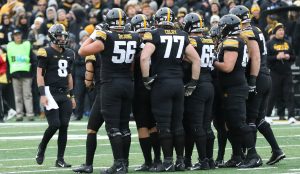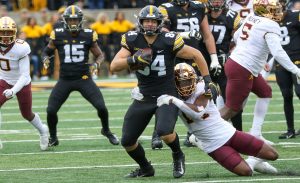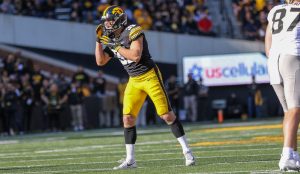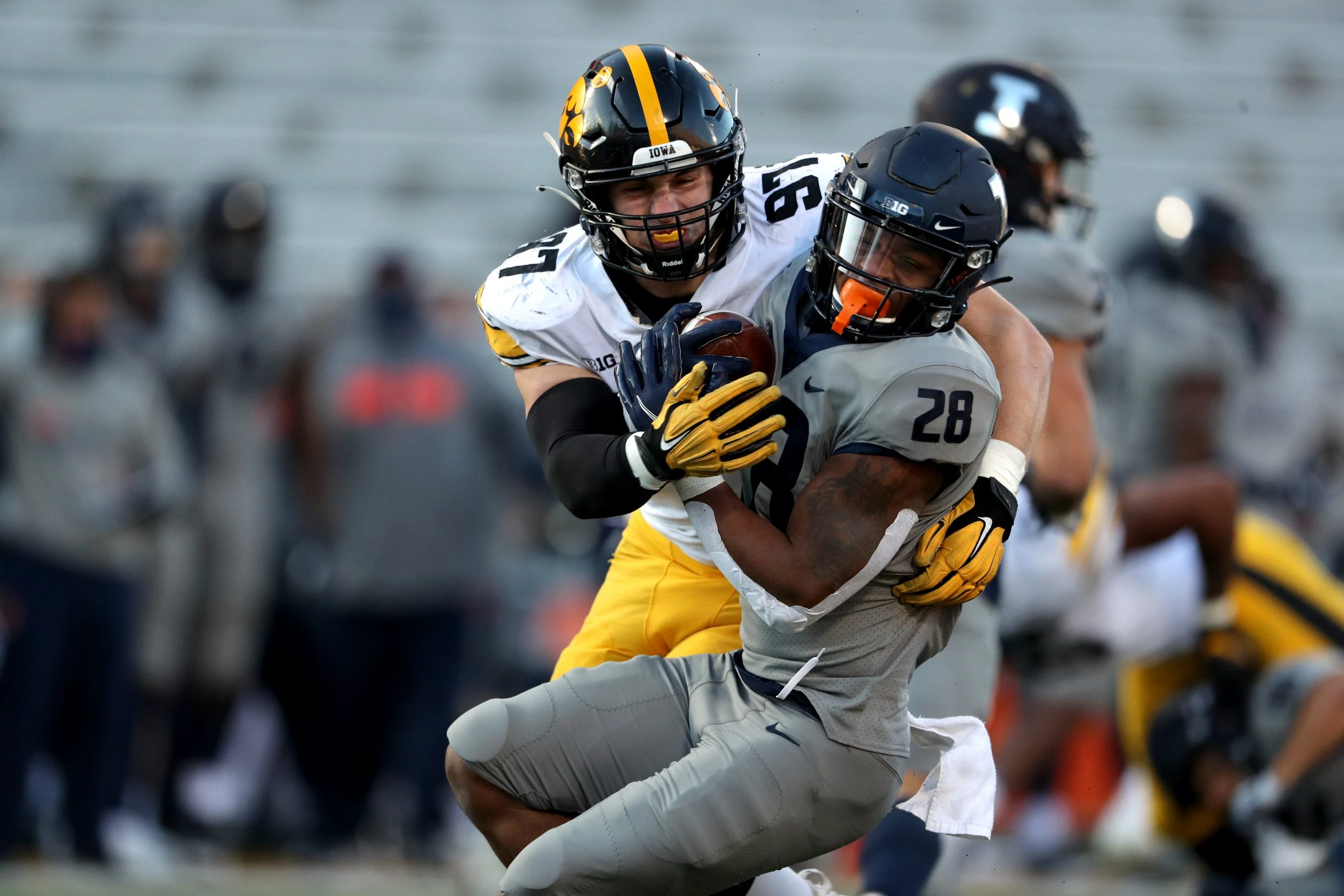Illinois vs. Iowa; which team has the advantage at nine different positions
By Pat Harty
IOWA CITY, Iowa – Iowa (8-2) has doubled Illinois (4-6) in wins this season, and it’s easy to see why when you breakdown each of the nine positions that it takes to win, especially on defense.
Illinois might have a slight edge overall on offense, but Iowa’s superiority on defense, and on special teams, helps to make up for that, and explains why Iowa is favored by 11 1/2 points heading into Saturday’s game at Kinnick Stadium.
The quarterback position is tough to pick which team has the advantage, because Alex Padilla has only started one game for Iowa, while Illinois quarterback Brandon Peters has played in 34 games, including 10 for Michigan in 2017 and 2018.
So, Peters clearly has the edge in experience heading into Saturday’s game, but he also has struggled at times, and hasn’t won many games.
It’ll be interesting to see how, or if, Bret Bielema’s absence on the sideline effects Illinois’ performance. Bielema, a former Iowa defensive lineman and assistant coach, will miss Saturday’s game after having tested positive for the coronavirus.
This game is important for lots of reasons, not the least of which is Iowa being tied for first place in the Big Ten West Division with Wisconsin with a 5-2 record.
However, the Badgers hold the tiebreaker based on having defeated Iowa 27-7 on Oct. 30 in Madison, Wisconsin.
Illinois has to win its final two games against Iowa and Northwestern to avoid having a losing record.
That could be a tall order, however, as the following matchups will help to illustrate.

Quarterback: Both teams have been impacted by injuries at this position, making this a tough call.
Alex Padilla provided a spark for the Iowa offense in each of the past two games after replacing the injured Spencer Petras, and Padilla is expected make his second career start on Saturday.
But that’s the problem with Padilla in that he has so little experience compared to Illinois quarterback Brandon Peters, who has started games for both Illinois and Michigan where he began his career.
Peters started the season opener, but was injured and then missed back-to-back games. He has since started five of the last six games, due partly to his backup, Artur Sitkowski having suffered a season-ending arm injury against Penn State.
Peters has 3,673 career passing yards and has thrown 29 touchdown passes and 12 interceptions. He passed for 1,884 yards and 18 touchdowns for Illinois in 2019.
But he also has been sacked 47 times and is only completing 53.9 percent of his passes.
There is chance that Petras might be healthy enough to play on Saturday, so that would give Iowa a backup quarterback with 17 career starts. It seems unlikely that Petras would start over Padilla, but you never say never.
So again, this is a close call, but experience ultimately makes the difference.
Advantage: Illinois
Running back: Both teams have talented feature backs, but Illinois sophomore Chase Brown is averaging about 25 more rushing yards per game than Iowa junior Tyler Goodson.
Brown enters Saturday’s game against Iowa ranked fourth in the Big Ten in rushing, averaging 106.38 yards per game, while Goodson is averaging 81.3 rushing yards per game.
Brown is also averaging 5.9 yards per carry, while Goodson is averaging 4.3 yards per carry.
Brown has rushed for at least 145 yards in each of Illinois’ last two road games against Penn State and Minnesota. His 223 rushing yards at Beaver Stadium were the most by an opponent at Beaver Stadium, and the fourth most-ever against Penn State.
Freshman Josh McCray, also gives Illinois a nice chance of pace from weighing about 240 pounds. He has 491 rushing yards this season and is averaging 5.2 yards per carry.
Advantage: Illinois
Wide receiver: This is another close call as neither team has a star at this position, but they both have some reliable pass catchers. Illinois redshirt freshman Isaiah Williams is second among Power Five freshmen with 38 catches for 376 yards and two touchdowns.
A converted quarterback, Williams set an Illinois record for rushing yards by a quarterback when he gained 195 yards against Rutgers last season as a true freshman. So he, obviously, is dangerous after making the catch.
Sophomore Casey Washington has played in all 10 games this for Illinois and has 16 receptions for 165 yards, while junior Donny Navarro has 15 catches for 133 yards.
Iowa has five receivers with at least 15 catches, led by Nico Ragaini with 23, while true freshman Keagan Johnson leads the Iowa receivers with 316 receiving yards and with a 21.1 yards-per-catch average.
Johnson’s role has increased significantly in the last few games as he gives Iowa a deep threat.
Advantage: Iowa

Tight end: This is an easy choice based on what Sam LaPorta has accomplished this season. The junior leads Iowa with 37 catches for 425 yards and two touchdowns.
Illinois, on the other hand, doesn’t have a tight end with more than 14 receptions.
Advantage: Iowa
Offensive line: I put a lot of emphasis on which team has a more productive rushing attack when choosing who has the advantage on the offensive line.
Iowa has without question the best offensive lineman in junior center Tyler Linderbaum. But Illinois is averaging 180.2 rushing yards per game, while Iowa is only averaging 109.6 rushing yards per game.
Iowa also has struggled with pass protection and is averaging just 3.1 yards per carry as a team.
Advantage: Illinois
Defensive line: Iowa has six defensive linemen with at least 19 tackles, led by senior end Zach VanValkenburg with 39 stops, including 9 1/2 for loss.
Illinois has three defensive linemen with at least 19 tackles, led by redshirt freshman Jer’Zhan Newton with 37.
Iowa also has six defensive linemen with at least 2 1/2 tackles for loss, and four with at least 3 1/2 tackles for loss, while Illinois only has three defensive linemen with more than three tackles for loss and none with more than 3 1/2.
Iowa is also ranked fourth in the conference in rushing defense, allowing 107.6 yards per game, while Illinois is ranked 10th in the conference in rushing defense, allowing 152.4 rushing yards per game.
The statistics clearly favor Iowa at these positions.
Advantage: Iowa

Linebacker: Iowa has two linebackers – Jack Campbell and Seth Benson – ranked in the top 16 in the conference in tackles, while Illinois doesn’t have any linebackers ranked in the top 20 in the conference in tackles. Campbell leads Iowa with 100 tackles and his average of 10 tackles per game ranks third in the Big Ten. Campbell also has six pass breakups, three quarterback hurries, two fumble recoveries, including one that he returned for a touchdown against Iowa State, and 2 1/2 tackles for loss.
Sophomore Tarique Barnes leads the Illinois linebackers, and is ranked 23rd in the conference with 68 tackles. Junior Jake Hansen is second amongst the Illinois linebackers with 33 tackles, while Jestin Jacobs is third amongst the Iowa linebackers with 42 tackles despite only playing part time due to Iowa often using five defensive backs and just two linebackers.
Advantage: Iowa
Defensive backs: Iowa leads the country with 19 interceptions and ranks third in takeaways with 24 largely because of these guys. Iowa is also close to full strength with the return of senior cornerback Riley Moss, who missed three games with a knew injury.
Moss and Iowa safety Dane Belton both have four interceptions, as does Illinois defensive back Joseph Kerby. Moss has returned two of his interceptions for touchdowns.
Illinois has four defensive backs that are ranked in the top 50 in the Big Ten in tackles, led by Sydney Brown with 70, but that isn’t necessarily a sign of strength.
Safety Jack Koerner leads the Iowa defensive backs with 69 tackles.
Senior cornerback Matt Hankins also has three interceptions for Iowa.
Advantage: Iowa
Special teams: From a statistical standpoint, Iowa has the edge at punter, kicker and in the return game.
Senior Caleb Shudak has made 14-of-16 field-goal attempts for Iowa, while James McCourt has made 11-of-16 attempts for Illinois.
Iowa punter Tory Taylor is averaging 45.76 yards on 63 punts and has placed 30 punts inside the opponent’s 20-yard line. Taylor also has 19 punts that have covered at least 50 yards.
Illinois senior Blake Hayes isn’t far behind Taylor with an average of 44.97 yards on 58 punts. Hayes also has placed 27 of his punts inside the opponent’s 20-yard line.
Charlies Jones gives Iowa a huge edge in the return game as he ranks near the top in the conference in kick returns and punt returns with averages of 22.9 and 10.42, respectively.
Advantage: Iowa



